The Role of Information Management for the Sustainable Conservation of Cultural Heritage
Abstract
1. Introduction
- When dealing with curative conservation and restoration, there is a need (before acting) to gather any piece of information that contributes to the knowledge about the object, not only as the previous restorations are concerned, but also regarding the history, meaning, materials, techniques, legal status and so on, in order to decide the most suitable actions to be undertaken in each case [2]; this need becomes especially obvious when dealing with cases in which the documentation does not exist or where it is very scarce (e.g., [3]);
- As regards preventive conservation, careful consideration should be given to both the object itself—including its uses and management conditions—and the surrounding environment to detect conservation problems or risks, and then to enable the design of maintenance protocols, monitoring strategies and emergency response measures that are applied methodically over time in the framework of a continuous improvement [4].
- At present, cultural heritage is seen as something dynamic; therefore, the meaning of restoration has shifted from actions that—to a greater or lesser degree—“affect” the heritage to events that contribute to its material history [7]. Likewise, the criteria for restoration have evolved inasmuch as the technologies for the study of the materials and their durability over time have been developed; today, it is known that the products applied in the restoration works (consolidating products, waterproofing materials, biocides, etc.) are not reversible—i.e., they cannot be removed without damaging the material integrity of the object due to infiltration into the porous structure and the changes caused by exposure to aggressive environments (solar radiation, pollution, marine aerosol, etc.). On the contrary, the application of products modifies the intrinsic characteristics of the materials on which they are applied and conditions subsequent to retreatment;
- Restorations are no longer considered as exceptional corrective actions that must go unnoticed for the users. Conversely, restoration actions should be understood within the process of permanent maintenance of the elements of heritage, which has to be known and open to the public [8]. The combination of information from different fields generates knowledge that permits the development of attractive cultural activities [9]. In the same vein, the outreach of the conservation-restoration works is a way of attracting visitors and, hence, generating economic returns. It also benefits the interest and the citizen engagement in safeguarding cultural heritage, the awareness of its meaning, the generation of a collective memory and the promotion of a sense of belonging and identity. Consequently, threats related to inappropriate use and looting are reduced, as well as human action, which is one of the main causes of deterioration;
- The third substantial change is the trend to steer the conservation to prevention and the risk management, rather than to the physical action on the elements, through the development and implementation of preventive conservation plans [10,11]; in this way, the deteriorations and losses are avoided without drastic and costly treatments on the objects that could eventually imply a reduction of their durability and authenticity [12]. The identification and evaluation of the risks are based on studies of the current and past situation of the heritage element and its surroundings, by using tools for quantifying the probability of occurrence of each risk, its impact, the extension and the estimation of the resulting loss in value [13,14]. Current methods resort to a series of indexes, such as the vulnerability index, which combines static and structural factors, weather conditions, air quality, urban planning and social agents [15,16]; another method used is the heritage microclimate risk (HMR) index, which defines a level of risk to which the elements are exposed and the relationship with the minimum and maximum values that are defined by standards or according to the historic microclimate, together with the predicted risk of damage (PRD) index, which links the HMR value with the damage risk to a specific object/material that is shown or conserved in a room [17], among others. Moreover, it must also be considered that, owing to climate change and the exponential growth in the deterioration processes of the materials caused by the increasingly aggressive environments, the monitoring and the documentation of these environmental conditions have become strategic for the basic preventive conservation, markedly for cities and coastal areas [18,19]. Finally, information also plays an essential role in dealing with catastrophic events such as natural disasters and armed conflicts, as is illustrated in the disaster risk management (DRM) cycle for cultural heritage [20].
2. Materials and Methods
2.1. “Open Data” of Public Administrations
2.2. Repositories and Cultural Aggregators
- (a)
- The following picture (Figure 3) shows a university repository which contains reports and results of projects for the geometric documentation of heritage elements [32]. There is no need to dwell on the importance of the information about the geometry and the appearance of the elements in order to track the evolution over time (photographs, line drawings, orthoimages, 3D models, etc.); however, when it comes to preparing the datasets for preservation, it is necessary to retain only the pieces of information that can be reused, store them in standard formats and describe the records according to the specifications of repositories and aggregators. Another concern is the process of rights clearance and the attribution of licenses for the reuse of the information that is provided, especially due to the complex web of relationships which appears when working with cultural heritage elements (artists, owners, custodians, providers, collaborators, etc.). Finally, in order to be considered by a cultural aggregator, the repository has to comply with a series of technical specifications regarding the accessibility, data quality standards and being in line with the scope;
- (b)
- In the same way, the picture below (Figure 4) shows the repository of the IAPH, which stores the information about the interventions on cultural heritage managed by this organization, technical documentation, information materials for public use, training materials, research reports and so on. The management strategy of this organization encompasses the entire life cycle of the documents from the very moment that the intervention concludes [33]. This approach not only guarantees that the information is properly preserved and available for reuse, but also contributes to the generation of more reliable and authentic documents. At present, the repository particularly contains information on movable heritage, but it is expected that it will soon also include more information about other types (the information in the repository is continually growing; in order to have an up-to date view, see: https://repositorio.iaph.es/handle/11532/1, accessed: 15 February 2021).
2.3. Geographic and Three-Dimensional Databases
3. Results
4. Discussion
- The 3D modeling implies the formal definition of a semantic about the building process and this work requires an important amount of time and resources, whether for a HBIM generated from scratch or from unstructured 3D information (such as point clouds); there are some attempts to alleviate the workload by means of tools for the semiautomatic generation, but they are still in their initial stages [65]. Therefore, HBIM systems can be time-consuming and expensive solutions, which also means that they cannot be applied to every case;
- Many authors have proposed the maximum geometric accuracy as the fundamental basis for the development of the HBIM systems [66,67]. This consideration, however, may disregard one interesting feature of the BIM technology: the possibility of progressively improving the quality of the models thanks to the definition of the levels of development (LOD), or better yet, the levels of knowledge (LOK), which allows for the adaptation of the model to the needs of each case, creator and end user. For instance, the two HBIM models presented in this paper showed accentuated contrasts in scale, purpose, geometric accuracy and information content; thus, they were developed in different levels of knowledge. Nevertheless, a LOK200 model like the Charterhouse one may gradually evolve to a higher LOK; symmetrically, a LOK400 model of a fragment of a heritage building, like the Renaissance Quadrant Façade, can be linked to a broader model in a lower LOK in order to contextualize the information stored in it;
- On the other hand, the architectural model is not the only type of relevant information for conservation purposes; therefore, the establishment of connections with other sources is also necessary, and this cannot always be done inside the HBIM. Thus, it might be interesting to export the structured knowledge outside the BIM to contextual (semantic) environments such as CIDOC-CRM [68,69], ConML (Conceptual Modeling Language) [70] or another specific domain ontology [71]. In addition, the connection among different HBIM systems remains to be solved; to this end, several options have been suggested such as the creation of networks of nodes [72] or solutions via the exportation to external formats such as CityGML (an application schema for the Geography Markup Language) [73,74];
- Finally, the operation of the HBIM requires specialized training and equipment (hardware and software) that is out of reach of most potential users. In this regard, more intuitive complementary tools have been proposed to facilitate management by non-expert users, such as interactive 360° panoramic views—coming from real image, virtual models or mixed reality—where information can be presented by means of hot points superimposed over the images [75].
- (a)
- If interoperability and immediate availability of the information for remote users are sought, the best option is to become a provider to an already existent environment, such as the network of repositories that are connected through aggregators or the SDI. Sometimes, the organization may have to set up the systems from scratch, which entails, on the one hand, the acquisition and maintenance of hardware and specific software and, on the other hand, staff training. This was the case for the two systems established by the IAPH (digital guide and repository). In other cases, the information is transferred to organizations which already have operational systems. This second option was the selected one in the examples of the SDI (that are managed by the regional mapping services of La Rioja and Andalusia, respectively) and the university repository. The differences are not just restricted to the costs and the time frame, because they may also affect the control over datasets and the technological expertise that the organization will gain as a result of the implementation. Consequently, each organization should evaluate its situation with respect to these aspects;
- (b)
- For the internal use of the information, a suitable digital asset management (DAM) system must be chosen. This may only include basic functionalities if the resources (financial and technical) of the organization are limited or it may take advantage of some improved capabilities. Certainly, these capabilities enable new uses, which might justify the choice, as were the cases of the HBIM models presented in the text, but the initial costs are important either way;
- (c)
- It ought to be noted that, currently, there is no consistent tool for comprehensive management of both the internal and remote uses that encompass the historical documentation, monitoring, technical work and dissemination. In the meantime, the organizations need to develop different information systems in parallel, which involves a considerable workload, which should not be underestimated at the time of a new system implementation, for selecting, transforming and reprocessing the information.
- It may be interesting to note the shift in attention from the data publishing to the development of tools for data analysis which, eventually, are expected to work autonomously [79];
- The challenge of integrating heterogeneous sources of cultural heritage knowledge will remain a field of joint study for computer scientists and domain specialists [80];
- The interconnection with other technologies, such as natural language processing (both for the content analysis of the documents and for the processing of the queries) or machine learning (with interesting applications in dealing with uncertainty, incomplete and fuzzy data, which are common characteristics of the information in the cultural heritage field);
- The optimization of interfaces and work processes is important, as many tools and software currently in use (such as Revit, Gephi, QGIS, etc.) require extensive data conversion into accepted formats. This entails huge efforts in terms of training on the use of each software to generate visualizations, models and analyses;
- Finally, it must not be forgotten that the ultimate aim of the information is to improve the management of conservation works, and thus, the maintenance and use of the heritage. Usage and impact monitoring are essential in order to justify the investments, which will entail the participation of actors from multiple areas such as economics, sociology, education or law.
5. Conclusions
- Data provided by the public administrations according to the “open data” policy, including the SDI; that is to say, information delivered by means of map layers;
- Repositories, for the distributed storage of any kind of information;
- HBIM, i.e., a detailed digital replica of the element of heritage considering its geometry structured on the basis of the architectural semantic, where each element can be connected to many thematic datasets.
Author Contributions
Funding
Institutional Review Board Statement
Informed Consent Statement
Data Availability Statement
Acknowledgments
Conflicts of Interest
References
- CEN—European Committee for Standardization. EN 15898:2019—Conservation of Cultural Heritage—Main General Terms and Definitions; CEN—European Committee for Standardization: Brussels, Belgium, 2019. [Google Scholar]
- CEN—European Committee for Standardization. EN 16853:2017—Conservation of Cultural Heritage. Conservation Process. Decision Making, Planning and Implementation; CEN—European Committee for Standardization: Brussels, Belgium, 2017. [Google Scholar]
- Pasíes, T. Los trabajos de conservación-restauración en el laboratorio del Museo de Prehistoria de Valencia: Problemática de las antiguas restauraciones. PH Investig. 2014, 3, 1–19. [Google Scholar]
- Herráez, J.A.; Pastor, M.J.; Durán, D. Guía Para la Elaboración e Implantación de Planes de Conservación Preventiva; Departamento de Conservación Preventiva, Instituto del Patrimonio Cultural de España (IPCE), Ministerio de Cultura y Deporte: Madrid, Spain, 2019. [Google Scholar]
- Cruz, A.J.; Revez, M.J.; Figueira, F. On the importance of publishing in Heritage conservation. Conserv. Patrim. 2017, 27, 7–10. [Google Scholar] [CrossRef]
- Culubret, B.; Dávila, C.; Moreno, A. Documentando la restauración… pasado, presente y futuro. Boletín Mus. Arqueol. Nac. 2017, 36, 387–404. [Google Scholar]
- Gómez, A. Las intervenciones arquitectónicas en el palacio del Almirante de Aragón en Valencia (principios del siglo XX). Virtual Archaeol. Rev. 2020, 11, 116–136. [Google Scholar] [CrossRef]
- Lasagabaster, J.I. Del “abierto por obras” al “abierto por mantenimiento”. In Proceedings of the IV GE-ICC conference “¿Y después? Control y mantenimiento del Patrimonio Cultural, una opción sostenible”, Vitoria-Gasteiz, Spain, 20–22 September 2018; pp. 24–33. [Google Scholar]
- Nascimento, V.G.; Baptista Pereira, F.A.; Candeias, A.; Nogueira Alves, A. Um projeto de salvaguarda integrada: Estratégias de preservação e de comunicação de retábulos integrados em ermidas. Conserv. Património 2018, 27, 103–110. [Google Scholar] [CrossRef]
- García Fernández, I.M. Historia de la conservación preventiva. Parte I. Ge-Conservación 2013, 5, 27–41. [Google Scholar] [CrossRef]
- García Fernández, I.M. Historia de la conservación preventiva. Parte II. Ge-Conservación 2014, 6, 5–18. [Google Scholar] [CrossRef][Green Version]
- Cirujano, C.; García, Á.L.; Laguna, T. El mantenimiento de los bienes culturales como garantía para su conservación. Ge-conservación 2009, 21–33. [Google Scholar] [CrossRef]
- Fernández, C.; Levenfeld, C.; Monereo, A. La evaluación de riesgos en patrimonio. Del diagnóstico al pronóstico. Patrim. Cult. De España 2013, 7, 57–69. [Google Scholar]
- Ramalhinho, A.R.; Macedo, M.F. Cultural heritage risk analysis models: An overview. Int. J. Conserv. Sci. 2019, 10, 39–58. [Google Scholar]
- Ortiz, R.; Ortiz, P. Vulnerability Index: A New Approach for Preventive Conservation of Monuments. Int. J. Archit. Herit. 2016, 10, 1078–1100. [Google Scholar] [CrossRef]
- Ortiz, R.; Macias-Bernal, J.M.; Ortiz, P. Vulnerability and buildings service life applied to preventive conservation in cultural heritage. Int. J. Disaster Resil. Built Environ. 2018, 9, 31–47. [Google Scholar] [CrossRef]
- Fabbri, K.; Bonora, A. Two new indices for preventive conservation of the cultural heritage: Predicted risk of damage and heritage microclimate risk. J. Cult. Herit. 2020. [Google Scholar] [CrossRef]
- Camuffo, D. Microclimate for Cultural Heritage: Conservation, Restoration, and Maintenance of Indoor and Outdoor Monuments, 3rd ed.; Elsevier Science: Amsterdam, The Netherlands, 2019. [Google Scholar]
- Hassan, M.; Xie, H. Climate Change and Conservation of Coastal Built Heritage; Springer: Singapore, 2020. [Google Scholar]
- Vafadari, A.; Philip, G.; Jennings, R. Damage assessment and monitoring of cultural heritage places in a disaster and post-disaster event—A case study of Syria. Int. Arch. Photogramm. Remote Sens. Spat. Inf. Sci. 2017, XLII-2/W5, 695–701. [Google Scholar] [CrossRef]
- Zhou, M.; Geng, G.; Wu, Z. Digital Preservation Technology for Cultural Heritage; Springer: Berlin/Heidelberg, Germany, 2012. [Google Scholar]
- Carrión, A. Planes Nacionales de Patrimonio Cultural; Ministerio de Educación, Cultura y Deporte: Madrid, Spain, 2015. [Google Scholar]
- McKeague, P.; Corns, A.; Shaw, R. Developing a Spatial Data Infrastructure for Archaeological and built heritage. Int. J. Spat. Data Infrastruct. Res. 2012, 7, 38–65. [Google Scholar] [CrossRef]
- Fernández-Freire, C.; del-Bosque-González, I.; Vicent-García, J.M.; Pérez-Asensio, E.; Fraguas-Bravo, A.; Uriarte-González, A.; Fábrega-Álvarez, P.; Parcero-Oubiña, C. A Cultural Heritage Application Schema: Achieving Interoperability of Cultural Heritage Data in INSPIRE. Int. J. Spat. Data Infrastruct. Res. 2012, 8, 74–97. [Google Scholar] [CrossRef]
- Cuca, B.; Brumana, R.; Scaioni, M.; Oreni, D. Spatial data management of temporal map series for cultural and environmental heritage. Int. J. Spat. Data Infrastruct. Res. 2011, 6, 97–125. [Google Scholar] [CrossRef]
- Mascort-Alea, E.J. Datos geográficos abiertos para la conservación preventiva del patrimonio arquitectónico. Rev. PH 2017, 92, 228–229. [Google Scholar] [CrossRef]
- Martínez de Toda, F.; Ocete, R.; Prado, E.; Rodríguez, Á.; Valle, J.M. La vid silvestre en La Rioja (España): Situación actual y difusión mediante Infraestructuras de Datos Espaciales. Zubía 2017, 29, 95–120. [Google Scholar]
- Freire, N.; Meijers, E.; Voorburg, R.; Isaac, A. Aggregation of cultural heritage datasets through the Web of Data. Procedia Comput. Sci. 2018, 137, 120–126. [Google Scholar] [CrossRef]
- Hitzler, P. A review of the Semantic Web Field. Tracig the triumphs and challenges of two decades of Semantic Web research and applications. Commun. ACM 2021, 2, 76–83. [Google Scholar] [CrossRef]
- Coburn, E.; Light, R.; Lindenthal, J.; McKenna, G.; Stein, R.; Vitzthum, A.; Weidling, M. (Eds.) LIDO v1.1 Public Beta—Lightweight Information Describing Objects; ICOM-CIDOC LIDO Working Group: Paris, France, 2020. [Google Scholar]
- Bekiari, C.; Bruseker, G.; Doerr, M.; Ore, C.; Stead, S.; Velios, A. (Eds.) Definition of the CIDOC Conceptual Reference Model (Version 7.1); ICOM-CIDOC: Paris, France, 2021. [Google Scholar]
- Rodríguez, Á.; Valle, J.M. Los repositorios institucionales dentro de las estrategias de preservación de la información sobre patrimonio. Rev. PH 2017, 92, 230–231. [Google Scholar] [CrossRef]
- Acosta, P. Documenting knowledge. Document management of intervention projects on immovable heritage. In Science and Digital Technology for Cultural Heritage: Interdisciplinary Approach to Diagnosis, Vulberability, Risk Assessment and Graphic Information Models; Ortiz, P., Pinto, F., Verhagen, P., Prieto, A., Eds.; CRC Press; Taylor & Francis: Abingdon, UK, 2019; pp. 176–180. [Google Scholar]
- González, C. Information Modelling for Archaeology and Anthropology; Springer: Berlin/Heidelberg, Germany, 2018. [Google Scholar]
- Ferreira-Lopes, P.; Pinto Puerto, F. GIS and Graph Models for Social, Temporal and Spatial Digital Analysis in Heritage: The case-study of Ancient Kingdom of Seville Late Gothic Production. Digit. Appl. Archaeol. Cult. Herit. 2018, 9, 1–14. [Google Scholar] [CrossRef]
- Vanrell, A. Propuestas de organización y la visualización de datos para mejorar la gestión y comprensión de obras complejas. Conserv. Património 2019, 30, 117–130. [Google Scholar] [CrossRef]
- Medeiros, F.; Vilar, H.V.; Moreiro González, J.A. Construction of a taxonomy for medieval Portuguese history: Problems and challenges. Rev. Española De Doc. Científica 2016, 39, e123. [Google Scholar] [CrossRef][Green Version]
- Arminsen, A. BIM Aplicado al Patrimonio Cultural. Guía de Usuarios BIM; documento 14; Building Smart Spain: Barcelona, Spain, 2018. [Google Scholar]
- Jordan-Palomar, I.; Tzortzopoulos, P.; Pellicer, E. Protocol to manage heritage-building interventions using heritage building information modelling (HBIM). Sustainability 2018, 10, 908. [Google Scholar] [CrossRef]
- Oliveira, D.V.; Masciotta, M.G. HeritageCare: “Prevenir mejor que curar”. Rev. PH 2019, 96, 16–18. [Google Scholar] [CrossRef]
- Mora, R.; Sánchez-Aparicio, L.J.; Maté-González, M.Á.; García-Álvarez, J.; Sánchez-Aparicio, M.; Gozález-Aguilera, D. An historical building information modelling approach for the preventive conservation of historical constructions: Application to the Historical Library of Salamanca. Autom. Constr. 2021, 121, 103449. [Google Scholar] [CrossRef]
- Cascón-Katchadourian, J.; Ruiz-Rodriguez, A.A.; Alberich-Pascual, J. Revisión, análisis y evaluación de sistemas para la gestión de activos multimedia en organizaciones. Rev. Española Doc. Científica 2018, 41, e196. [Google Scholar] [CrossRef]
- Castellano, M.; Pinto, F. Dimensions and Levels of Knowledge in Heritage Building Information Modelling, HBIM: The model of the Charterhouse of Jerez (Cadiz, Spain). Digit. Appl. Archaeol. Cult. Herit. 2019, 14, e00110. [Google Scholar] [CrossRef]
- Angulo-Fornos, R.; Castellano-Román, M. HBIM as Support of Preventive Conservation Actions in Heritage Architecture. Experience of the Renaissance Quadrant Façade of the Cathedral of Seville. Appl. Sci. 2020, 10, 2428. [Google Scholar] [CrossRef]
- Nys, G.; Van Ruymbeke, M.; Billen, R. Spatio-Temporal Reasoning in CIDOC CRM: An Hybrid Ontology with GeoSPARQL and OWL-Time. In Proceedings of the 2nd Workshop On Computing Techniques for Spatio-Temporal Data in Archaeology and Cultural Heritage, Melbourne, Australia, 28 August 2018; Belussi, A., Billen, R., Hallot, P., Migliorini, S., Eds.; RWTH Aachen University: Aachen, Germany, 2018; pp. 37–50. [Google Scholar]
- Dulong de Rosnay, M.; Janssen, K. Legal and Institutional Challenges for Opening Data across Public Sectors: Towards Common Policy Solutions. J. Theor. Appl. Electron. Commer. Res. 2014, 9, 1–14. [Google Scholar] [CrossRef]
- Medrano, I. Datos abiertos en instituciones culturales. Rev. PH 2017, 92, 212–220. [Google Scholar] [CrossRef]
- Huijboom, N.; Van den Broek, T. Open data: An international comparison of strategies. Eur. J. Epractice 2011, 12, 1–13. [Google Scholar]
- González-Vares, I. Conservación de Bienes Culturales [Conservation of Cultural Items]; Manuales Arte Cátedra: Madrid, Spain, 2006. [Google Scholar]
- Migilinskas, D.V.; Popov, V.; Juocevicius, L. The benefits, obstacles and problems of practical BIM implementation. Procedia Eng. 2013, 57, 767–774. [Google Scholar] [CrossRef]
- Sulé, A.; Centelles, M.; Franganillo, J.; Gascón, J. Aplicación del modelo de datos RDF en las colecciones digitales d bibliotecas, archivos y museos de España. Rev. Española De Doc. Científica 2016, 39, e121. [Google Scholar] [CrossRef][Green Version]
- IAPH. ReA, el Repositorio de Activos Digitales del IAPH, disponible en su web. Rev. PH 2016, 89, 22–23. [Google Scholar] [CrossRef]
- García Vicente, J.J. Los repositorios en acceso abierto como elemento central en la transferencia de conocimiento entre los profesionales del patrimonio. In Las Profesiones del Patrimonio Cultural. Competencias, Formación y Transferencia del Conocimiento: Reflexiones y Retos en el Año Europeo del Patrimonio Cultural 2018; Galán, A., Pardo, D., Eds.; GE-ICC & ACRE: Madrid, Spain, 2018; pp. 474–481. [Google Scholar]
- Europeana. Strategy 2020–2025. Empowering Digital Change. 2020. Available online: https://pro.europeana.eu/page/strategy-2020-2025-summary (accessed on 4 January 2021).
- Koroso, I.; Muñoz, O. 12 years of archaeological data digital registry at the Santa María Cathedral of Vitoria-Gasteiz (1997–2009). In CAA2010: Fusion of Cultures: Proceedings of the 38th Annual Conference on Computer Applications and Quantitative Methods in Archaeology, Granada, Spain, 6–9 April 2010; BAR S2494; Contreras, F., Farjas, M., Melero, J., Eds.; Archaeopess: Oxford, UK, 2013; pp. 1–7. [Google Scholar]
- De Luca, L.; Véron, P.; Florenzano, M. Semantic description and multi-representation in architecture. In Proceedings of the Conference: Virtual Retrospect 2005, Biarritz, France, 5–7 November 2005; Archéovision 2. Vergnieux, R., Delevoie, C., Cocula, A.-M., Eds.; Ausonius: Pessac, France, 2006; pp. 31–37. [Google Scholar]
- Nieto, J.E.; Moyano, J.J.; Rico, F.; Antón, D. Management of built heritage via the HBIM project: A case study of flooring and wall tiling. Virtual Archaeol. Rev. 2016, 7, 1–12. [Google Scholar] [CrossRef]
- Banfi, F. HBIM, 3D drawing and virtual reality for archaeological sites and ancient ruins. Virtual Archaeol. Rev. 2020, 11, 16–33. [Google Scholar] [CrossRef]
- Campiani, A.; Lingle, A.; Lercari, N. Spatial analysis and heritage conservation: Leveraging 3-D data and GIS monitoring earthen architecture. J. Cult. Herit. 2019, 39, 166–176. [Google Scholar] [CrossRef]
- Salvador, E. Protocolo HBIM Para Una Gestión Eficiente del Uso Público del Patrimonio Arquitectónico. Ph.D. Thesis, Universitat Politècnica de València, Valencia, Spain, April 2020. Available online: http://hdl.handle.net/10251/146811 (accessed on 15 February 2021).
- Jouan, P.; Hallot, P. Digital twin: Research framework to support preventive conservation policies. Int. J. Geo-Inf. 2020, 9, 228. [Google Scholar] [CrossRef]
- Kadi, H.; Anouche, K. Approche paramétrique pour la reconstitution 3D basée sur la connaissance préalable. Conserv. Património 2019, 30, 47–58. [Google Scholar] [CrossRef]
- Chiabrando, F.; Lo Turco, M.; Rinaudo, F. Modeling the decay in an HBIM starting from 3D point clouds. A followed approach for cultural heritage knowledge. Int. Arch. Photogramm. Remote Sens. Spat. Inf. Sci. 2017, XLII-2/W5, 605–612. [Google Scholar] [CrossRef]
- Tsilimantou, E.; Delegou, E.T.; Nikitakos, I.A.; Ioannidis, C.; Moropoulou, A. GIS and BIM as integrated digital environments for modeling and monitoring of historic buildings. Appl. Sci. 2019, 10, 1078. [Google Scholar] [CrossRef]
- Bassier, M.; Bonduel, M.; Derdaele, J.; Vergauwen, M. Towards the semantic enrichment of existing online 3D building geometry to publish linked building data. In KGSWC 2019; CCIS 1029; Villazón-Terrazas, B., Hidalgo-Delgado, Y., Eds.; Springer Nature: Cham, Switzerland, 2019; pp. 134–148. [Google Scholar] [CrossRef]
- Mateos, F.; Valdeón, L.; Rojo, A.; Armisén, A.; García, B. Plataforma virtual para el diseño, planificación, control, intervención y mantenimiento en el ámbito de la conservación del patrimonio histórico “PetroBIM”. In Proceedings of the Rehabend 2016, Burgos, Spain, 24–26 May 2016; pp. 1374–1382. [Google Scholar]
- Garagnani, S.; Manferdini, A.M. Parametric Accuracy: Building Information Modeling Process Applied to the Cultural Heritage Preservation. ISPRS—Int. Arch. Photogramm. Remote Sens. Spat. Inf. Sci. 2013, XL-5/W1, 87–92. [Google Scholar] [CrossRef]
- Henninger, M. From mud to the museum: Metadata challenges in archeology. J. Inf. Sci. 2018, 44, 658–670. [Google Scholar] [CrossRef]
- Parisi, P.; Lo Turco, M.; Giovannini, E.C. The value of knowledge through H-BIM models: Historic documentation with a semantic approach. Int. Arch. Photogramm. Remote Sens. Spat. Inf. Sci. 2019, XLII-2/W9, 581–588. [Google Scholar] [CrossRef]
- Martin-Rodilla, P.; Gonzalez-Perez, C. Metainformation scenarios in digital humanities: Characterization and conceptual modelling strategies. Inf. Syst. 2019, 84, 29–48. [Google Scholar] [CrossRef]
- Quattrini, R.; Pierdicca, R.; Morbidoni, C.; Malinverni, E.S. Conservation-oriented HBIM. The BIMEXPLORER web tool. Int. Arch. Photogramm. Remote Sens. Spat. Inf. Sci. 2017, XLII-5/W1, 275–281. [Google Scholar] [CrossRef]
- Brumana, R.; Ioannides, M.; Previtali, M. Holistic heritage building information modelling (HHBIM): From nodes to hub networking, vocabularies and repositories. Int. Arch. Photogramm. Remote Sens. Spat. Inf. Sci. 2019, XLII-2/W11, 309–316. [Google Scholar] [CrossRef]
- Matrone, F.; Colucci, E.; De Ruvo, V.; Lingua, A.; Spanò, A. HBIM in a semantic 3D GIS database. Int. Arch. Photogramm. Remote Sens. Spat. Inf. Sci. 2019, XLII-2/W11, 857–865. [Google Scholar] [CrossRef]
- Noardo, F.; Ellul, C.; Harrie, L.; Overland, I.; Shariat, M.; Arroyo Ohori, K.; Stoter, J. Opportunities and challenges for GeoBIM in Europe: Developing a building permits use-case to raise awareness and examine technical interoperability challenges. J. Spat. Sci. 2020, 65, 209–233. [Google Scholar] [CrossRef]
- Sánchez-Aparicio, L.J.; Masciotta, M.G.; García-Alvarez, J.; Ramos, L.F.; Oliveira, D.V.; Martín-Jiménez, J.A.; González-Aguilera, D.; Monteiro, P. Web-GIS approach to preventive conservation of heritage buildings. Autom. Constr. 2020, 118, 103304. [Google Scholar] [CrossRef]
- Ramos-Simón, L.F. Uso de las licencias libres en los datos públicos abiertos. Rev. Española Doc. Científica 2017, 40, e179. [Google Scholar] [CrossRef]
- Muir, A. Digital preservation: Awareness, responsibility and rights issues. J. Inf. Sci. 2004, 30, 73–92. [Google Scholar] [CrossRef]
- Rodríguez, Á.; Korro, J.; Valle, J.M. Archivo y difusión de contenidos 3D de elementos patrimoniales en repositorios institucionales y plataformas comerciales. Rev. PH 2020, 100, 78–80. [Google Scholar] [CrossRef]
- Hyvönen, E. Using the Semantic Web in digital humanities: Shift from data publishing to data-analysis and serendipidous knowledge discovery. Semant. Web 2020, 11, 187–193. [Google Scholar] [CrossRef]
- Bruseker, G.; Carboni, N.; Guillem, A. Cultural heritage data management: The role of formal ontology and CIDOC CRM. In Heritage and Archaeology in the Digital Age, Quantitative Methods in the Humanities and Social Sciences; Vincent, M., López-Menchero Bendicho, V., Ioannides, M., Levy, T., Eds.; Springer International Publishing AG: Cham, Switzerland, 2017; pp. 93–131. [Google Scholar] [CrossRef]
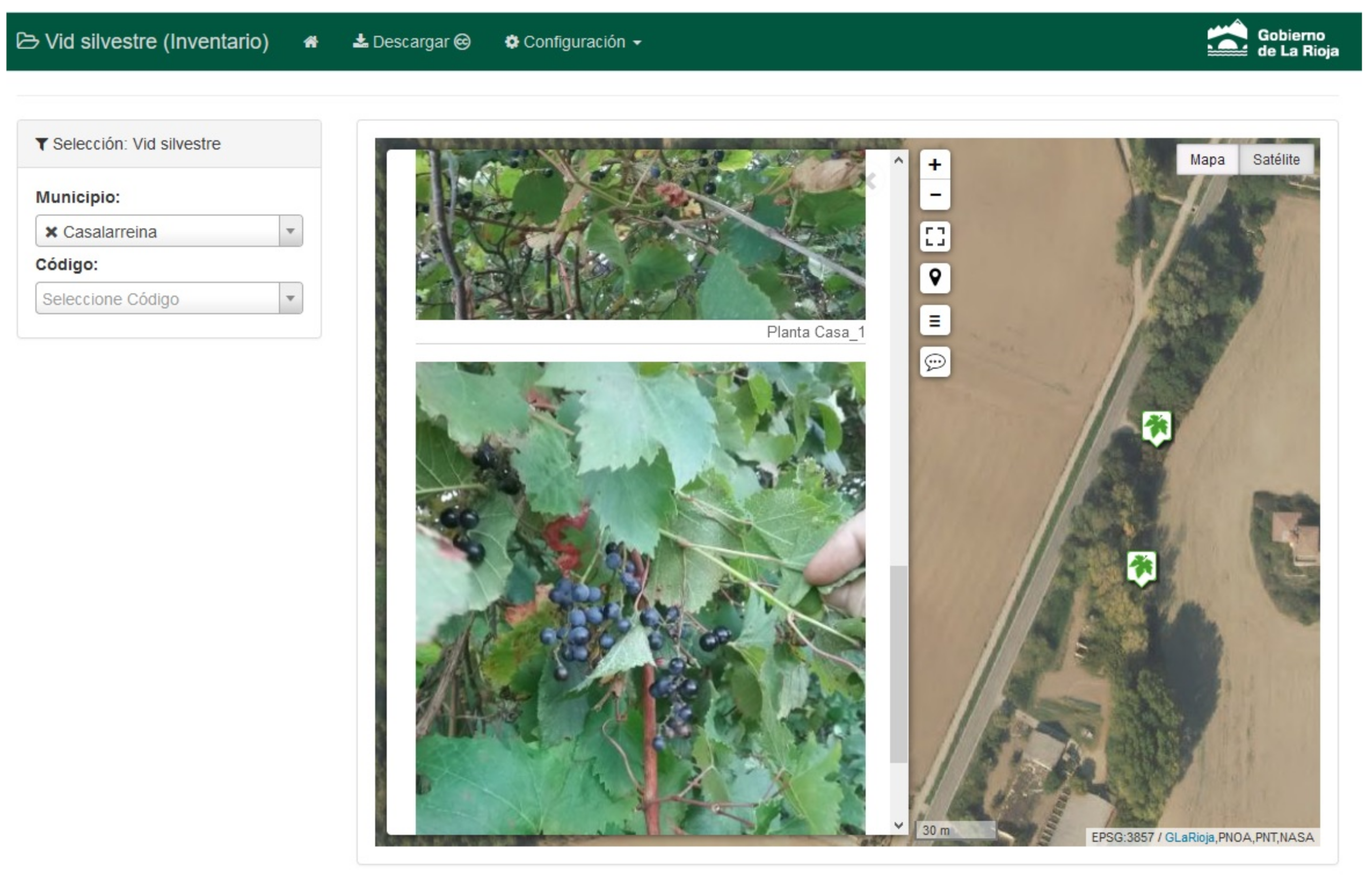
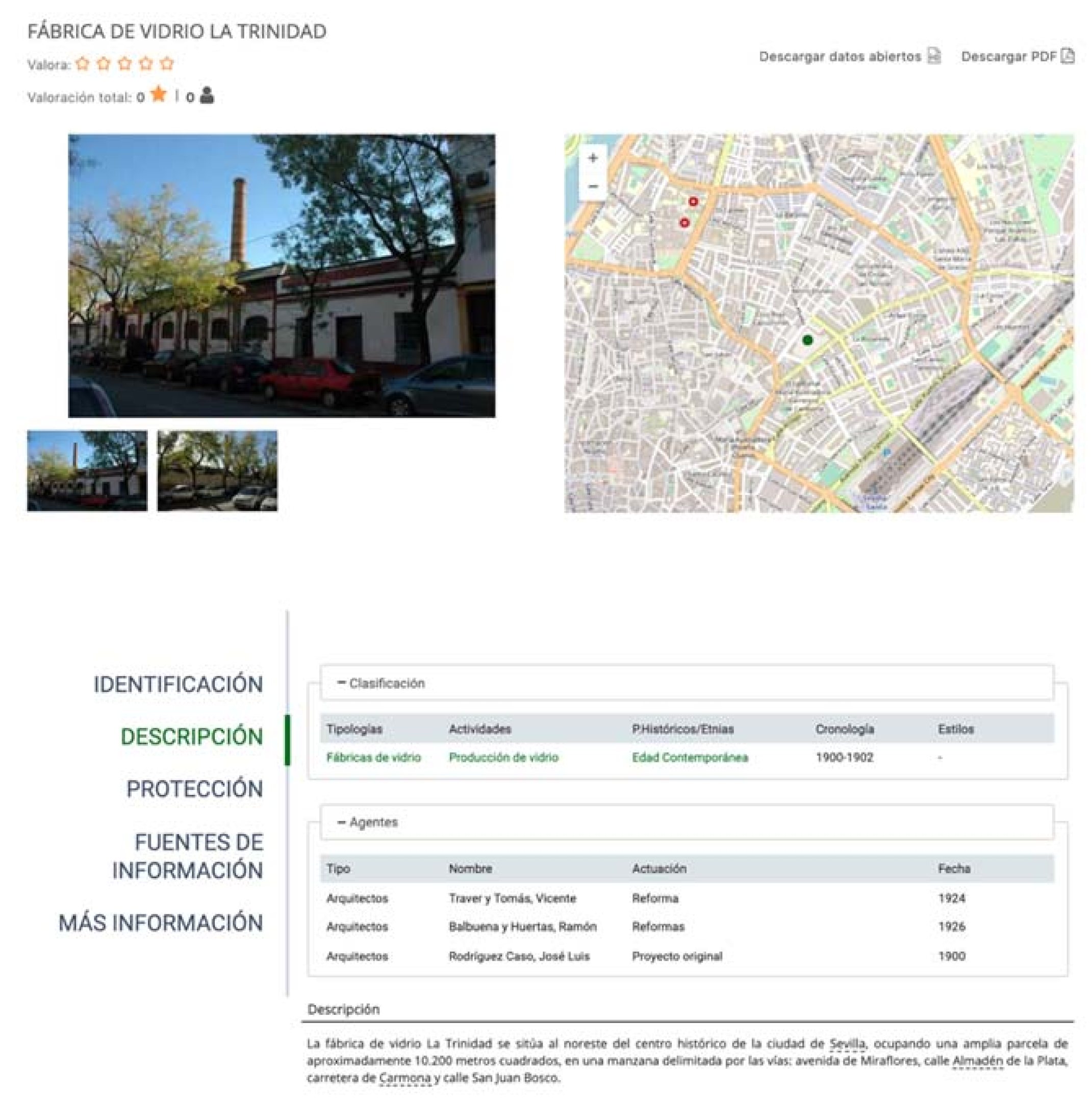
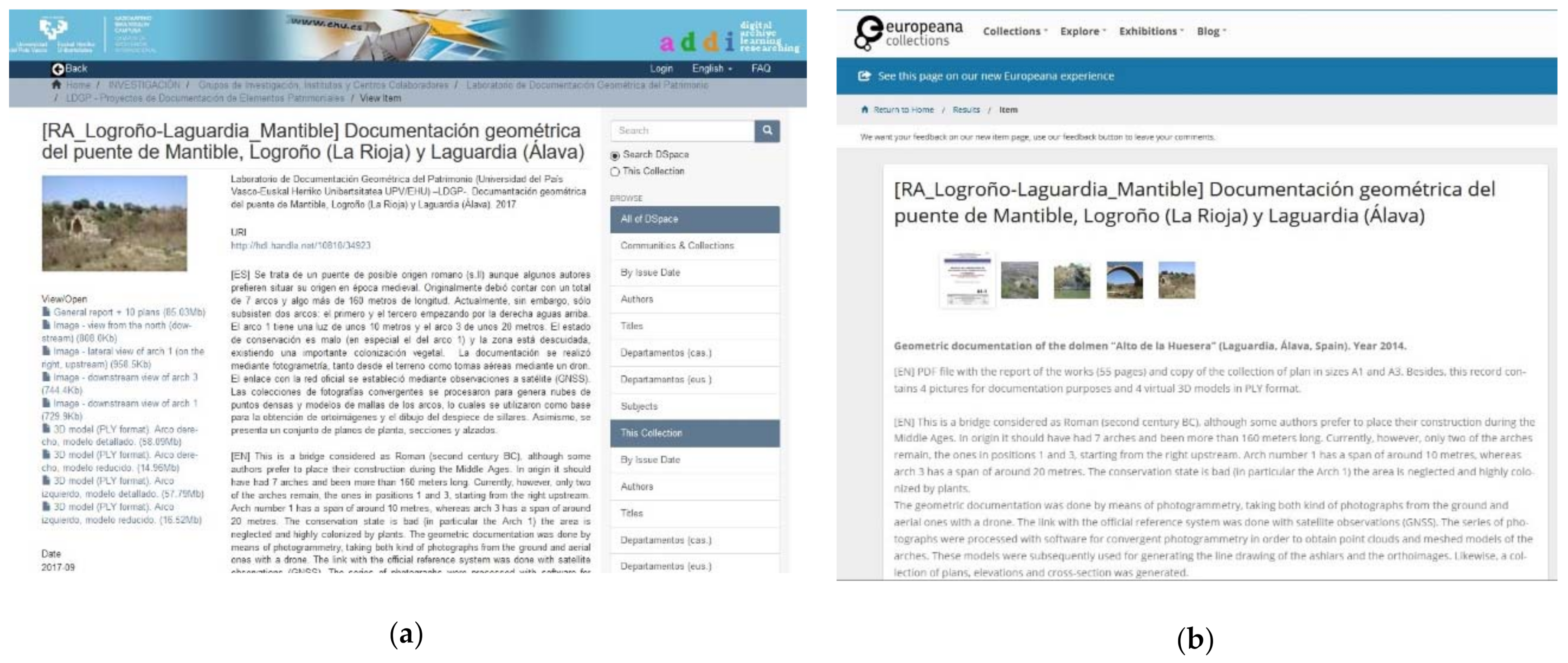
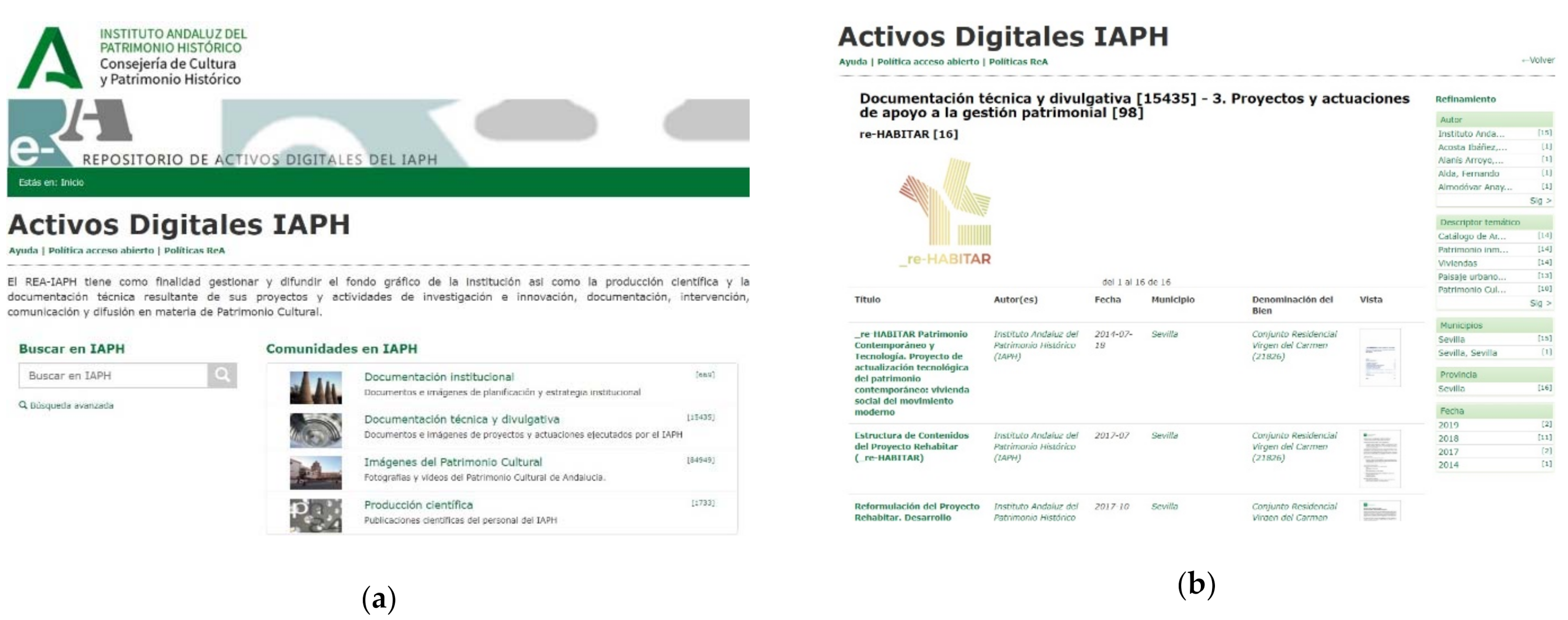
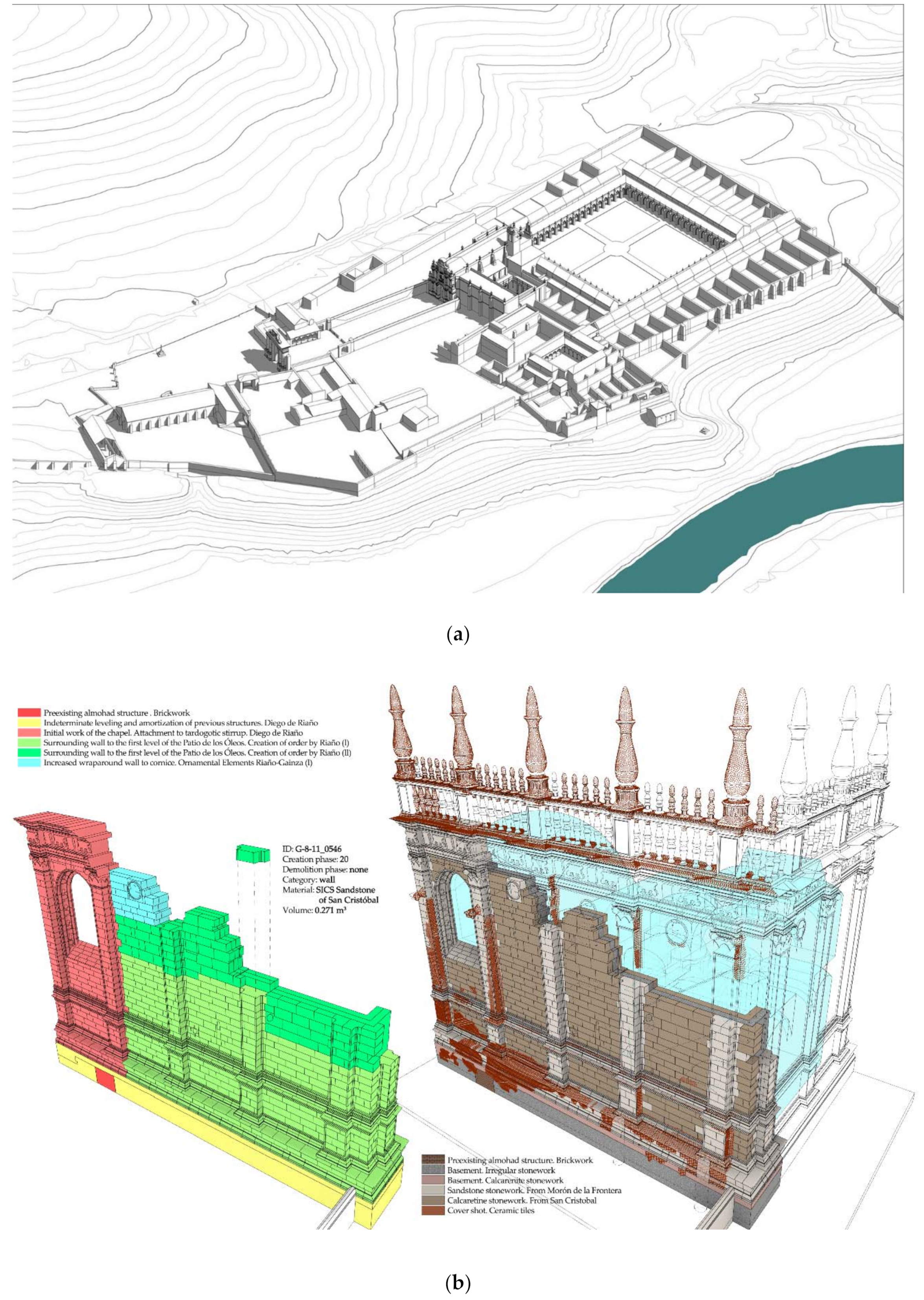
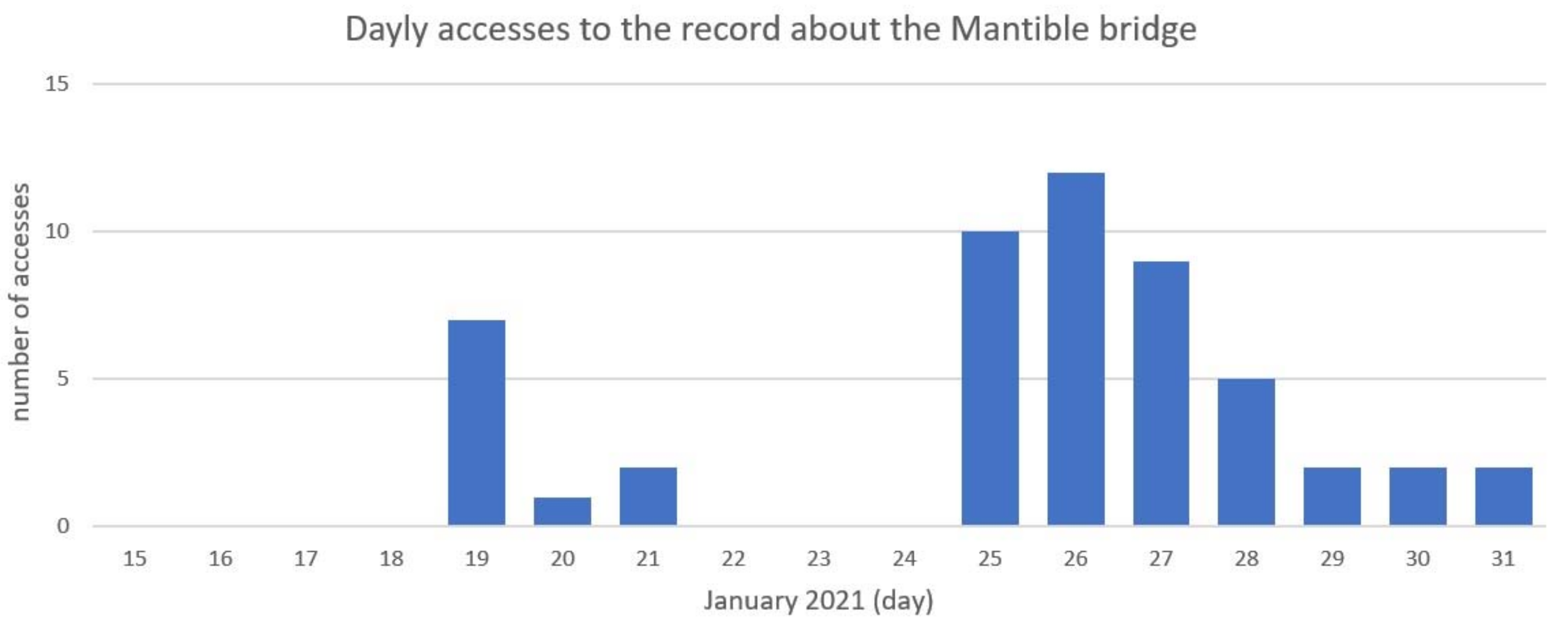
| Open Data | Repositories | 3D Databases | |||
|---|---|---|---|---|---|
| SDI | Digital Guide | University | IAPH | HBIM | |
| 1. Information types | Map coverages | Texts, maps, images and thesaurus | Anything | Texts and images | 3D elements |
| 2. Information about the element of heritage or the surrounding environment | Environment (mainly) | Both | Both | Both | Element (mainly) |
| 3. Advanced built-in tools for data processing | Some geoprocessing tools | No | No | No | Yes |
| 4. Indexation tools | OGC Catalogue Services | OGC Catalogue Services and Aggregators (OAI-PMH) | Aggregators (OAI-PMH) | Aggregators (OAI-PMH) | Not yet available |
| 5. Online and interoperable accessibility | Yes | Yes | Yes | Yes | No |
| 6. Information for experts or for general public | Experts | Both | Both | Both | Experts |
| 7. Management transferred to an external permanent organization | Yes | No | Yes | No | No |
| 8. Development costs | Low | Medium | Low | Medium | High |
Publisher’s Note: MDPI stays neutral with regard to jurisdictional claims in published maps and institutional affiliations. |
© 2021 by the authors. Licensee MDPI, Basel, Switzerland. This article is an open access article distributed under the terms and conditions of the Creative Commons Attribution (CC BY) license (https://creativecommons.org/licenses/by/4.0/).
Share and Cite
Korro Bañuelos, J.; Rodríguez Miranda, Á.; Valle-Melón, J.M.; Zornoza-Indart, A.; Castellano-Román, M.; Angulo-Fornos, R.; Pinto-Puerto, F.; Acosta Ibáñez, P.; Ferreira-Lopes, P. The Role of Information Management for the Sustainable Conservation of Cultural Heritage. Sustainability 2021, 13, 4325. https://doi.org/10.3390/su13084325
Korro Bañuelos J, Rodríguez Miranda Á, Valle-Melón JM, Zornoza-Indart A, Castellano-Román M, Angulo-Fornos R, Pinto-Puerto F, Acosta Ibáñez P, Ferreira-Lopes P. The Role of Information Management for the Sustainable Conservation of Cultural Heritage. Sustainability. 2021; 13(8):4325. https://doi.org/10.3390/su13084325
Chicago/Turabian StyleKorro Bañuelos, Jaione, Álvaro Rodríguez Miranda, José Manuel Valle-Melón, Ainara Zornoza-Indart, Manuel Castellano-Román, Roque Angulo-Fornos, Francisco Pinto-Puerto, Pilar Acosta Ibáñez, and Patricia Ferreira-Lopes. 2021. "The Role of Information Management for the Sustainable Conservation of Cultural Heritage" Sustainability 13, no. 8: 4325. https://doi.org/10.3390/su13084325
APA StyleKorro Bañuelos, J., Rodríguez Miranda, Á., Valle-Melón, J. M., Zornoza-Indart, A., Castellano-Román, M., Angulo-Fornos, R., Pinto-Puerto, F., Acosta Ibáñez, P., & Ferreira-Lopes, P. (2021). The Role of Information Management for the Sustainable Conservation of Cultural Heritage. Sustainability, 13(8), 4325. https://doi.org/10.3390/su13084325







